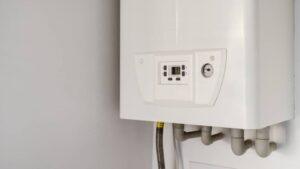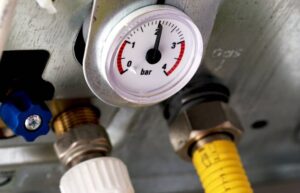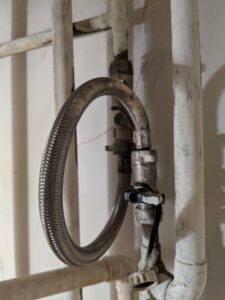What Should Boiler Pressure Be?

Estimated reading time: 9 Minutes
Maintaining the correct boiler pressure is essential for keeping your heating system running efficiently and safely. It’s essential not to leave it until the last minute to
check your boiler pressure and you’ll want to ensure you know how to adjust the pressure either by increasing the boiler pressure or lowering the boiler pressure before it’s too late.
If the pressure is too high or too low, it can cause problems like reduced heating performance or even boiler breakdowns. Regularly checking and adjusting your boiler pressure can help avoid costly repairs and ensure your home stays warm. In this guide, we’ll explain what the ideal boiler pressure should be and provide simple steps to adjust it if necessary.
Quick links:
What’s a ‘normal’ Boiler Pressure?
Signs of Incorrect Boiler Pressure
How to Lower Boiler Pressure
Steps to Lower Boiler Pressure
How to Increase Boiler Pressure
Steps to Increase Boiler Pressure
How to Repressurise a Boiler
Boiler Pressure FAQS
What’s ‘Normal’ Boiler Pressure?
Understanding the correct boiler pressure is key to maintaining an efficient and safe heating system. The last thing you want is your boiler breaking just when the weather drops in temperature. The boiler pressure refers to the amount of water pressure in the system, which allows your radiators to heat up and warm your home.
Ideal Boiler Pressure Range

Boiler pressure gauge at 2 bar
Cold Boiler: When your boiler is off or the system is cold, the pressure should typically sit between 1.0 and 1.5 bar on the pressure gauge.
When in Use: As the boiler heats up and the system is running, the pressure will increase slightly but should stay around 2.0 bar.
Maintaining the correct pressure within this range is crucial for your boiler’s efficiency. Too low, and the boiler may not be able to heat your home effectively; too high, and it can put unnecessary strain on the system resulting in faults or your boiler not lasting as long.
Signs of Incorrect Boiler Pressure
If boiler pressure is high: If the pressure gauge shows a reading above 2.5 bar, especially when the boiler is in use, this indicates high pressure, which could lead to problems like water leaks or boiler system failures.
If boiler pressure is low: If the pressure is below 1.0 bar, your boiler might struggle to work correctly, and you could experience issues like poor heating performance or the boiler shutting down entirely.
Knowing these ranges will help you spot and address boiler pressure problems before they escalate.
How to Lower Boiler Pressure
If your boiler pressure is too high (typically above 2.5 bar when the system is in use), it can cause issues like leaks, noisy pipes, and reduced efficiency. It’s important to lower the pressure to avoid potential damage to your system.
Here’s how to safely reduce boiler pressure:
Why Boiler Pressure May Be Too High
High boiler pressure can occur for several reasons:
Overfilling the system: If too much water has been added when repressurising the boiler, it can result in high pressure.
Faulty expansion vessel: The expansion vessel absorbs extra pressure as the water heats up. If it’s malfunctioning, then the pressure can rise too much.
Trapped air in the radiators: Air in the system can prevent water from circulating properly, raising the pressure. If you can hear a trickle noise coming from radiators this is a likely sign of trapped air.
Steps to Lower Boiler Pressure
- Turn Off the Boiler: Always switch off your boiler and let it cool down before adjusting the pressure. This helps to avoid burns or damage to the system.
- Bleed the Radiators: Bleeding your radiators releases some of the water in the system, which in turn reduces the pressure. Here’s how to do it:
- Use a radiator key to open the valve slightly.
- Have a towel or bowl handy to catch any water.
- As the air escapes, the water will start to trickle out. Once the water flows smoothly, close the valve.
- Use the Pressure Release Valve: Some boilers are equipped with a pressure release valve. If bleeding the radiators doesn’t sufficiently lower the pressure, this valve can release excess pressure. You’ll usually find the location of it in the boiler’s manual – it will likely have a red twist cap.
If you’re unsure then It’s best to consult a professional for safety. Contact Huttie for help with your home boiler system.
When to Seek Professional Help
If your boiler pressure continues to remain high even after bleeding the radiators or using the release valve, it may indicate an issue with internal parts, such as the expansion vessel or pressure relief valve. In such cases, contact professional heating engineers for a proper inspection to find the cause of the high pressure in the boiler.
How to Increase Boiler Pressure
Low boiler pressure (below 1.0 bar) can lead to poor heating performance, or even cause your boiler to shut down completely. If you notice your heating system isn’t working, or it’s not as efficient or your boiler pressure gauge is reading too low, you may need to increase the pressure. Here are some tips on how to safely raise boiler pressure.
Causes of Low Boiler Pressure
Low boiler pressure can occur due to:
- Leaks in the system: Even small leaks in radiators, pipes, or the boiler itself can cause a gradual drop in pressure.
- Air in the system: Air trapped in your radiators can prevent proper water circulation, leading to a drop in pressure.
- Bleeding radiators: After bleeding radiators release trapped air, you may notice a reduction in pressure as water is removed from the system.
Steps to Increase Boiler Pressure
- Turn Off the Boiler and Let it Cool: Always start by turning off your boiler and allowing it to cool down before adjusting the pressure. This ensures the system is safe to handle.
- Locate the Filling Loop: Most modern boilers are equipped with a filling loop, which is used to add water to the system. It’s usually a silver hose with two valves or levers, found beneath the boiler.

boiler filling loop
- Open the Valves: Slowly open both valves on the filling loop, allowing water to flow into the system. You’ll hear water moving, and the pressure gauge will start to rise.
- Monitor the Gauge: Keep an eye on the pressure gauge and stop once it reaches 1.0 – 1.5 bar. Be careful not to overfill, as this could lead to high pressure.
- Close the Valves: Once the pressure is correct, close both valves securely to stop water from entering the system. Make sure they’re fully closed to prevent future leaks.
Turn the Boiler Back On: Restart your boiler and check that the pressure remains stable when the system heats up.
Troubleshooting Persistent Low Pressure
If the pressure drops again after topping up the system, it could indicate an underlying issue. Inspect your radiators and pipes for signs of leaks, and if the problem persists, contact a qualified heating engineer to investigate further.
How to Repressurise a Boiler
Repressurising a boiler is a simple and common task that ensures your heating system is working efficiently. If your boiler pressure drops too low, typically below 1.0 bar, you may need to add water to the system to bring it back to the correct level. This process is known as repressurising. To repressurise your boiler follow the same steps above of how to increase the boiler pressure.
What Does Repressurising Mean?
Boilers will naturally lose pressure, especially after maintenance or radiator bleeding. Repressurising means adding water back into the system using a filling loop to restore the pressure to the ideal range (1.0–1.5 bar). This ensures proper heating performance.
Safety Precautions When Repressurising
- Always follow the manufacturer’s instructions for your specific boiler model.
- Don’t overfill the system; excess pressure can damage the boiler and the heating system.
- If you’re unsure or uncomfortable with the process, it’s best to seek professional help to avoid any potential risks.
Boiler Pressure FAQS
- What should my boiler pressure be when the heating is on?
When your heating is on, the boiler pressure typically rises slightly, but it should remain within the range of 1.5 to 2.0 bar. If it exceeds 2.5 bar, it may indicate a problem, and you should look at lowering the pressure.
- Why does my boiler pressure keep dropping?
There are several reasons why boiler pressure may drop, including small leaks in the system, air trapped in radiators, or recently bleeding radiators. Regularly checking for leaks or trapped air can help, but persistent pressure loss may require professional help.
- Is it dangerous if my boiler pressure is too high?
While most modern boilers have safety features to shut down if pressure gets too high, running your system at above 2.5 bar can lead to leaks or damage to internal components. If pressure continues to rise despite adjustments, it’s best to call a professional to inspect the system.
- How often should I check my boiler pressure?
You should check your boiler pressure at least once a month or more frequently during the colder months when the heating is in regular use. Regular checks help you catch any pressure issues early before they lead to larger problems.
- Can I use my boiler if the pressure is too low?
If the pressure is below 1.0 bar, the boiler may not work efficiently, or it might shut down completely. It’s essential to repressurise the boiler before attempting to use it to avoid further issues with the system.
Boiler Maintenance and Servicing from Huttie
Maintaining the correct boiler pressure is crucial for keeping your heating system running smoothly and efficiently. By regularly checking your pressure, knowing how to adjust it, and addressing any issues promptly, you can avoid common problems or damage to your boiler. Whether you need to lower or increase the pressure, following the simple steps outlined in this guide will help ensure your home stays warm and comfortable.
For professional assistance with boiler pressure issues including repairs, new boiler installations, or boiler servicing contact our expert team. We can help you with all your heating needs and ensure your boiler runs efficiently, helping you save on energy bills.
